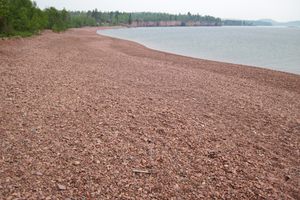About
In 1902, a business venture was born based on a serious blunder, which then started a tradition of profitable mistakes, including the Post-it note. It all began in Minnesota, in the former law office of John Dwan, where the five original 3M partners signed incorporation papers for a small mining interest that would grow to become an enormous multinational corporation.
The operation started out with corundum, which the enterprising prospectors were extracting from the western shores of Lake Superior to be sold to the sandpaper industry. A fairly obvious problem manifested when the lawyer, doctor, two railroad executives, and meat market owner realized that their partnership did not include a geologist.
What they thought was corundum, the extremely hard substance that is the basis of rubies and sapphires, was actually the much softer anorthosite. Scientists have long debated the mystery of how anorthosite is made, and businesses have long debated the mystery of how to make it profitable.
Undeterred, the 3Mers continued to raise capital and look for a use for their quarry. Eventually, they developed a specialty sandpaper called Wetordry, at which point the business finally crystallized into a going concern and began paying dividends in 1916.
One of the early visionaries behind 3M’s success was the legendary William L. McKnight, who was hired as an assistant bookkeeper in 1907 after a series of missteps. As the eventual CEO who spent 59 years at the company, McKnight embraced the serendipitous ethos of the company and formulated his “15 percent rule.” This required 3M researchers to spend 15 percent of their time on whatever idea interested them in order to encourage happy mistakes.
The now-indispensable line of Scotch tapes owes its existence to this philosophy. The inventor Richard Drew noted the problem that auto-body painters had with the process of masking cars for two-toned painting. After years of sticking with the problem, which was not part of his regular research duties, he finally developed a tape that would not damage auto-body paint. Ten years after its introduction, Scotch masking tape was generating over $1.5 million in sales.
Other inventions developed this way include the Scotchlite, which grew out of a failed attempt to make reflective road stripes; Scotchguard, which was developed when a researcher spilled a fluorochemical on her shoes; and the Post-it, which resulted from a failed glue.
The 3M Museum is located in the former John Dwan law office, where the group of prospectors first met over a century ago. Although the museum is small, its displays succeed in honoring the impressive innovations of the company's engineers.
Related Tags
Know Before You Go
The museum is only open Friday to Sunday from 11 a.m. to 4 p.m and only from May 28 - Oct 24, 2023
Published
October 16, 2018





























